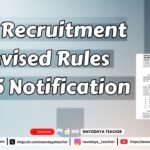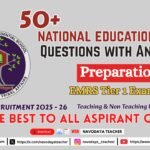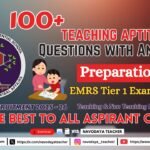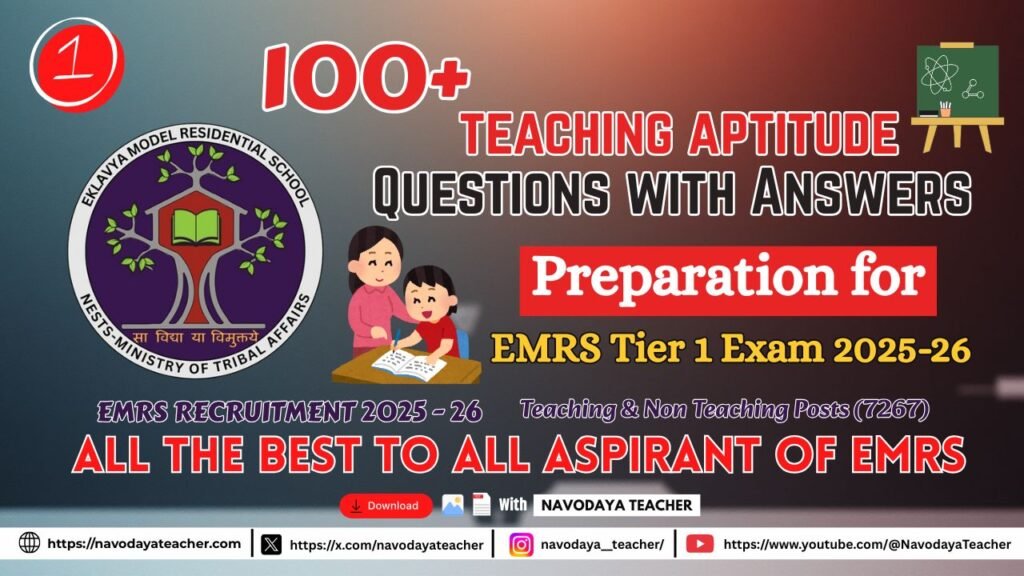In this article we providing information regarding latest 100 Teaching Aptitude Questions with Answers for EMRS Tier 1 Exam 2025-26
100 Teaching Aptitude Questions with Answers for EMRS Tier 1 Exam 2025-26
We are Providing To the Point Content for the your Upcoming Examination EMRS Tier 1 Exam 2025-26.
This will Helpful For TGT, PGT and All other Posts.
1. Effective teaching, by and large, is a function of :
- Teacher’s positive attitude towards teaching
- Teacher’s ability to make students learn – Answer
- Teacher’s honesty
- Teacher’s scholarship
2. Which of the following is not an example of ‘Assessment of Learning’ ?
- Scholarship Examination
- Anecdotal Records
- Annual Examination
- Assessment of Homework – Answer
3. If students are not taking interest in their studies, the teacher should :
- File a complaint with the principal and parents and seek their indulgence.
- Find out causes for lack of interest and take corrective measures. – Answer
- Ask them as to why they are not taking interest
- Tell them that taking interest would lead to good.
4. Which one of the following is not associate with a unit test ?
- Totally controlled by the teacher
- Used for remedial purpose
- Standardized Achievement Tests – Answer
- Confined to limited number of competencies
5. Which one of the following is not a characteristics of teacher-centred approach?
- Enough scope for discussion and debate is available – Answer
- Courses prescribed can be completed in time
- Large sized classes are handled very well.
- Unfamiliar or abstract concepts are directly explained by the teacher
6. Pedagogy is the study of ____.
- Education
- Teaching Methods – Answer
- Learning process
- Guiding Students
7. Teaching is defined as _______
- Facilitation of learning – Answer
- Transmission of knowledge by teachers and its reception by the students
- Reading the textbooks
- Transmission of knowledge by teachers
8. Most important work of teacher is _____
- To organize teaching work – Answer
- To evaluate the students
- To deliver lecture in class
- To take care of children
9. Effective teaching by and large, is a function of _
- Maintaining discipline in the class
- Teachers honesty
- Teacher’s making students learn and understand – Answer
- Teacher’s liking for the job of teaching
10. Why is teacher training necessary ?
- Increase teaching skills
- Understand methods of school organization
- Upgrade knowledge of content
- All of the above – Answer
11. A teacher gives a lot of positive and negative examples in his/ her presentations in the classroom. This will be related to which level teaching?
- Autonomous development level
- Memory level
- Understanding level – Answer
- Reflective level
12. During teaching, a teacher’s statements that encourage students to elaborate on an answer, either their own or that of others will be called,
- Structuring
- Instructional variety
- Engagement in the learning process
- Probing – Answer
13. Which one of the following statements about teaching is not correct?
- Teaching is an interactive process.
- Teaching is a tripolar process.
- Teaching is an effect-directed process.
- Teaching is a process confined only to the classrooms. – Answer
14. A type of learning in which students try to learn by emerging new rule through given learning material, is known as what?
- Rote learning
- Meaningful learning
- Reception learning
- Discovery learning – Answer
15. A plan prepared by a teacher to teach a lesson is called
- Unit plan
- Lesson plan – Answer
- Course plan
- Master plan
16. The first and foremost requisite for effective lesson planning is
- sincerity and dedication
- knowledge of different approaches and methods of teaching
- thorough knowledge of the subject matter – Answer
- availability of teaching resources
17. The communication process is active and interactive at a very high level in which of the following level of teaching?
- Reflective level
- Understanding level – Answer
- Memory level
- Autonomous development level
18. Given below are two statements, one is labelled as Assertion A and the other is labelled as Reason R
- Assertion A: Teachers must encourage students to ask questions.
- Reason R: Asking questions can create curiosity and develop passion for learning
In light of the above statements, choose the most appropriate answer from the options given below
- Both A and R are correct and R is the correct explanation of A – Answer
- Both A and R are correct but R is NOT the correct explanation of A
- A is correct but R is not correct
- A is not correct but R is correct
19. The teacher is considered a guide because
- The potential for building the society of the future is immense. – Answer
- He is a symbol of social trust.
- He is a caretaker to the society.
- He indulges in shaping the frustrations.
20. An effectively communicative teacher will ensure –
- Uniformity in learning – Answer
- Student-learning outcomes
- Changes in personal ideals
- Cultural integration
21. Arrangement of content or topic elements in a sequence follows the maxim of–
- From known to unknown
- From simple to difficult
- From concrete to abstract
- All of the above – Answer
22. Which of the following is/are the feature/s of Reflective level of teaching?
- Students learn by understanding the facts and information.
- Teaching is nothing but learning the subject by rote.
- Development of problem-solving ability.
- The student’s original thinking and creative abilities.
- The pupils are kept in strict disciplines and cramming is insiste(d)
Choose the correct answer from the options given below:
- (2) and (3) only
- (4) and (5) only
- (1) and (2) only
- (3) and (4) only – Answer
23. The Phrase T-L model of teaching implies that
- Teaching and learning are independent acts
- Teaching and learning are integrally related acts – Answer
- Teaching aims at learning
- Teaching causes learning
24. The goal of teaching as compared to training is to provide the opportunity of:
- Promotion of organized ideas as a result of disciplined drill
- Sharing and caring leading to critical and creative reflection – Answer
- Establishing beliefs and values leading to change in attitude
- Associating ideas which are similar and dissimilar
25. The quality of teaching is reflected:
- By the attendance of students in the class
- By the pass percentage of students
- By the quality of questions asked by students – Answer
- By the duration of silence maintained in the class
26. Which of the two given options is of the level of understanding?
- Define noun. List
- Define noun in your own words. – Answer
- Both (a) and (b)
- Neither (a) nor (b)
27. Which is the most important aspect of the teacher’s role in learning?
- The development of insight into what constitutes an adequate performance – Answer
- The development of insight into what constitutes the pitfalls and dangers to be avoided
- The provision of encouragement and moral support
- The provision of continuous diagnostic and remedial help
28. Which level of Bloom’s taxonomy involves interpreting, exemplifying, summarizing, and inferring meaning from written, oral, or graphic material?
- Remembering
- Understanding – Answer
- Applying
- Creating
29. Which is the characteristic of formative evaluation?
- Evaluation occurs at the terminal point
- Evaluation is used before programmed design progress
- Evaluation relates to indicating learning outcome of teaching
- Evaluation is conducted during teaching – Answer
30. For encouraging ‘learning to learn’, the emphasis on which of the following would be most appropriate?
- Use of educational technology gadgets
- Organizing teaching to increase opportunity for transfer of learning – Answer
- Assigning tasks to be mastered by students
- Frequent tests to be conducted
31. Which level of Bloom’s taxonomy involves interpreting, exemplifying, summarizing, and inferring meaning from written, oral, or graphic material?
- (a) Remembering
- (b) Understanding – Answer
- (c) Applying
- (d) Creating
32. Which is the characteristic of formative evaluation?
- (a) Evaluation occurs at the terminal point
- (b) Evaluation is used before programmed design progress
- (c) Evaluation relates to indicating learning outcome of teaching
- (d) Evaluation is conducted during teaching – Answer
33. For encouraging ‘learning to learn’, the emphasis on which of the following would be most appropriate?
- (a) Use of educational technology gadgets
- (b) Organizing teaching to increase opportunity for transfer of learning – Answer
- (c) Assigning tasks to be mastered by students
- (d) Frequent tests to be conducted
34. Are the following activities included in the phase of teaching – fixation, decision about the subject matter, arranging/sequencing the elements of content for presentation, determining the strategies of teaching, implementation of teaching strategies?
- (a) Pre-active – Answer
- (b) Interactive
- (c) Post-active
- (d) All of the above
35. Which of the following is an independent variable in the teachinglearning process?
- (a) Teacher – Answer
- (b) Student
- (c) Institution
- (d) Parents
36. Which of the following reflects the nature of teaching?
- (a) It is an art.
- (b) It is a science.
- (c) It is an art as well as a science. – Answer
- (d) It is neither art nor science.
37. Main aim of inclusive education will be achieved if the teacher:
- (a) Knows the diversity of the class – Answer
- (b) Prepares the report properly
- (c) Organizes the material targeted
- (d) Conducts proper testing of the class
38. An ideal lesson plan is:
- (a) Based on teaching levels
- (b) Objective based
- (c) Based on previous knowledge
- (d) All of the above – Answer
39. _ is considered as a sign of motivated teaching.
- (a) Maximum attendance in the class
- (b) Pin drop silence in the class
- (c) Remedial work given by the teacher
- (d) Questioning by students – Answer
40. “From Known to Unknown” is an example of which concept?
- a) Principle of Teaching
- (b) Method of Teaching
- (c) Aim of Education
- (d) Maxim of Teaching – Answer
41. Effective teaching is a function of:
- (a) Teacher’s honesty
- (b) Teacher’s scholarship
- (c) Teacher’s positive attitude towards teaching
- (d) Teacher’s ability to make students learn – Answer
42. Which of the following DOES NOT come under the cognitive domain of Bloom’s Taxonomy?
- (a) Synthesis
- (b) Application
- (c) Evaluation
- (d) Characterizing – Answer
43. A teacher uses a question-answer to ensure desired learning outcomes in his/her classroom. In this process, he/she offers the following type of comment to a few answers given by a student: “Yes, you are right, good”
- (a) Positive feedback – Answer
- (b) Negative feedback
- (c) Confirmatory feedback
- (d) Corrective feedback
44. Which of the following definitions of teaching emphasizes it as a process designed to bring about a change in the student’s behavior?
- (a)(B)O. Smith
- (b) Clark – Answer
- (c) John Brabacher
- (d) N.L. Page
45. Teaching differs from training and conditioning in so far as it promotes:
- (a) Disciplined drill
- (b) Critical thinking – Answer
- (c) Steady association
- (d) Mastery of facts
46. The tri-polar process of education was propounded by the ancients?
- (a) Charlotte Masson
- (b) Friedrich Froebel
- (c) John Dewey
- (d) Maria Montessori
47. In the tri-polar process of education, the third vertex adds another dimension to the bi-polar process. Which of the following represents it?
- (a) Parents
- (b) Teachers
- (c) Entertainment
- (d) Environment – Answer
48. In which of the following, the direction of influence is mainly one way:
- (a) Counselling
- (b) Guiding
- (c) Teaching
- (d) Learning – Answer
49. The emphasis from teaching to learning can be shifted by:
- (a) Encouraging rote learning
- (b) Adopting frontal teaching
- (c) Focusing on examination results
- (d) Adopting child-centered pedagogy – Answer
50. The most important function of the teacher is to__________
- (a) Guide students’ development – Answer
- (b) Provide remedial help whenever needed
- (c) Impart effective teaching
- (d) Maintain order and discipline in the class
51. ‘Cone of Experience’ related to teaching-learning was suggested by:
- (a) John Dewey
- (b) Kilpatrick
- (c) Froebel
- (d) Edgar Dale – Answer
52. Bloom’s Taxonomy is mainly related to :
- (a) Evaluation of teachers
- (b) Classification of educational objectives – Answer
- (c) Preparation of curriculum
- (d) Psychological testing
53. Which domain of Bloom’s Taxonomy deals with knowledge, thinking, and reasoning?
- (a) Cognitive Domain – Answer
- (b) Affective Domain
- (c) Psychomotor Domain
- (d) None of these
54. Receiving‛ is the lowest level of which domain?
- (a) Cognitive
- (b) Affective – Answer
- (c) Psychomotor
- (d) All of the above
55. Which of the following is the highest level in Bloom’s original Cognitive Domain?
- a) Application
- (b) Synthesis
- (c) Evaluation – Answer
- (d) Comprehension
56. Who revised Bloom’s Taxonomy in 2001 ?
- (a)Krathwohl and Anderson – Answer
- (b) Harrow and Dave
- (c) Skinner and Thorndike
- (d) Vygotsky and Piaget
57. In the revised taxonomy, which is placed at the highest level?
- (a) Evaluate
- (b) Analyse
- (c) Create – Answer
- (d) Apply
58. Which of the following belongs to the Psychomotor Domain ?
- a) Comprehension
- (b) Mechanism – Answer
- (c) Valuing
- (d) Synthesis
59. Which of the following levels is related to problem-solving ability?
- (a) Knowledge
- (b) Application
- (c) Comprehension
- (d) Evaluation – Answer
60. In Gagné’s theory, ‚StimulusResponse Learning‛ is most closely related to which other theory?
- A) Thorndike’s Connectionism
- B) Piaget’s Cognitive Development
- C) Köhler’s Insight Theory
- D) Skinner’s Operant Conditioning – Answer
61. According to Gagné, which prerequisite is most essential for ‚ProblemSolving‛ learning?
- A) Signal learning
- B) Rule learning
- C) Chaining
- D) Verbal association
62. According to Gagné’s learning hierarchy, if a child has not mastered simple chaining, he will face difficulty in which level of learning?
- A) Signal learning
- B) Verbal association
- C) Rule learning
- D) Problem-solving
63. According to Gagné, in which situation is ‚Verbal Association‛ learning most often applied?
- A) Solving mathematical problems
- B) Memorizing poems or definitions
- C) Developing new concepts
- D) Deriving rules
64. The maxim ‚From Concrete to Abstract‛ is most helpful in teaching which of the following subjects?
- A) Mathematics
- B) History
- C) Language
- D) Geography
65. Which maxim of teaching suggests that instruction should begin with the learner’s existing ideas and experiences?
- A) From Analysis to Synthesis
- B) From Known to Unknown
- C) From Induction to Deduction
- D) From Particular to General
66. The maxim ‚From Particular to General‛ is closely associated with which method of reasoning in teaching?
- A) Deductive method
- B) Inductive method
- C) Demonstration method
- D) Experimental method
67. Which maxim of teaching emphasizes that students’ natural curiosity and interest should be used to facilitate learning?
- A) From Psychological to Logical
- B) Learning by Doing
- C) From Simple to Complex
- D) From Concrete to Abstract
68. Which maxim is particularly useful in subjects like science, where facts need to be discovered before arriving at general principles?
- A) From Induction to Deduction
- B) From Concrete to Abstract
- C) From Simple to Complex
- D) From Analysis to Synthesis
69. Teaching is not a mere act of delivering knowledge but a process of:
- a) Skill training
- b) Value inculcation
- c) Bringing about desirable change in behavior
- d) Content memorization
70. “Skill performance” comes under which domain of Bloom’s taxonomy?
- a) Cognitive
- b) Affective
- c) Psychomotor
- d) Behavioral
71. According to Gagné, learning is a:
- a) Mechanical act
- b) Hierarchical process
- c) Biological growth
- d) Rote memorization
72. Understanding, interpretation, and summarization belong to which level of Bloom’s cognitive domain?
- a) Remembering
- b) Understanding
- c) Applying
- d) Evaluating
73. Which maxim emphasizes real-life experience for better learning?
- a) Induction to Deduction
- b) Concrete to Abstract
- c) Analysis to Synthesis
- d) Psychological to Logical
74. Which of the following is part of the interactive phase of teaching?
- a) Defining objectives
- b) Delivering content and asking questions
- c) Evaluation of learning outcomes
- d) Providing feedback
75. Bloom’s taxonomy helps teachers in:
- a) Preparing question papers
- b) Setting objectives in hierarchical order
- c) Evaluating only rote memory
- d) Ignoring affective learning
76.Gagné’s “Signal Learning” is closest to:
- a) Pavlov’s Classical Conditioning
- b) Skinner’s Operant Conditioning
- c) Kohler’s Insight Learning
- d) Bandura’s Observational Learning
77. The objective of pre-active phase is:
- a) To test students
- b) To plan for effective teaching
- c) To provide remedial measures
- d) To evaluate learning outcomes
78. The maxim “Psychological to Logical” suggests:
- a) Teaching according to teacher’s convenience
- b) Teaching according to learner’s mental level
- c) Ignoring learner’s needs
- d) Teaching only logical facts
79. Which of the following combinations is correct?
- a) Pre-active – Evaluation
- b) Interactive – Lesson Delivery
- c) Post-active – Planning
- d) Maxims – Rote Learning
80. Which of the following is NOT a feature of Understanding Level of Teaching?
- a) Explanation of concepts
- b) Generalization
- c) Habit formation
- d) Establishing relationships among facts
81. At which level of teaching are hypotheses formulated and tested?
- a) Memory level
- b) Understanding level
- c) Reflective level
- d) All of the above
82. A teacher is asking students to summarize the story in their own words. This activity belongs to:
- a) Memory level
- b) Understanding level
- c) Reflective level
- d) Drill level
83. At the Reflective Level of Teaching, the learner is expected to:
- a) Memorize facts
- b) Understand concepts
- c) Apply critical and creative thinking
- d) Perform mechanical practice
84. If a teacher focuses on cause-effect relationships, he/she is operating at:
- a) Memory level
- b) Understanding level
- c) Reflective level
- d) Drill level
85. he statement ‚A student learns to distinguish between facts and opinions‛
- a) Memory level
- b) Reflective level
- c) Understanding level
- d) Drill level
86. A teacher who asks students to debate on social issues is mainly using:
- a) Memory level teaching
- b) Understanding level teaching
- c) Reflective level teaching
- d) Drill teaching
87. What is the focus of concern in understanding level teaching?
- (a) Promotion of scope for seeking of relationship among facts and ideas
- (b) Encouraging recall and recognition of facts and information
- (c) Raising of problem and seeing solution to problem so presented
- (d) Developing a sense of happiness and ownership in learning
88. What are the activities of teaching associated with its interactive stage?
- (a) Planning of lesson
- (b) Determining learning outcomes
- (c) Presenting the content interspersed with question
- (d) Providing feedback and probing, if need be
- (e) Motivating and monitoring students tasks
89. The principle of starting from known to unknown helps in
- (a) Reducing fear of new learning
- (b) Making learning mechanical
- (c) Ignoring previous knowledge
- (d) Fixing syllabus only
90. The principle of activity in teaching means—
- A) Teacher should be more active
- (b) Students should learn by doing
- (c) Only games should be used
- (d) Activities are waste of time
91. The principle of whole to part is based on—
- (a) Gestalt psychology
- (b)Behaviorist psychology
- (c) Psychoanalysis
- (d) Structuralism
92. According to the principle of individual differences—
- (a) All students learn in the same way
- (b) Each learner is unique in ability and interest
- (c) Only intelligent students should be focused
- (d) Individual differences are obstacles
93. The principle of learning by doing is most closely associated with—
- (a) John Dewey
- (b) Froebel
- (c) Montessori
- (d) Skinner
94. The principle of motivation suggests—
- (a) Students must be forced to learn
- (b) Students learn better when interested
- (c) Teacher should motivate himself only
- (d) Exams are best motivators
95. The principle of socialization in teaching stresses—
- (a) Isolating the learner
- (b) Promoting cooperative and group learning
- (c) Learning in competition only
- (d) Teacher-centered strictness
96. A good teacher applies principles of teaching by—
- a) Using only one fixed method
- (b) Blending multiple methods as per learner’s need
- (c) Focusing only on syllabus completion
- (d) Ignoring child psychology
97. Continuity principle in teaching ensures /
- (a) Regular and systematic progress
- (b) Learning by doing
- (c) Interest in subject
- (d) Equality among learners
98. Which quality of a teacher helps them connect with student difficulties?
- (a) Subject mastery
- (b) Empathy
- (c) Authority
- (d) Discipline
99. Principle of Reinforcement was highlighted by
- (a) Skinner
- (b) Bruner
- (c) Piaget
- (d) Dewey
100. Learner-centred approach is based on
- a) Structuralism
- (b) Idealism
- (c) Behaviourism
- (d) Constructivism











